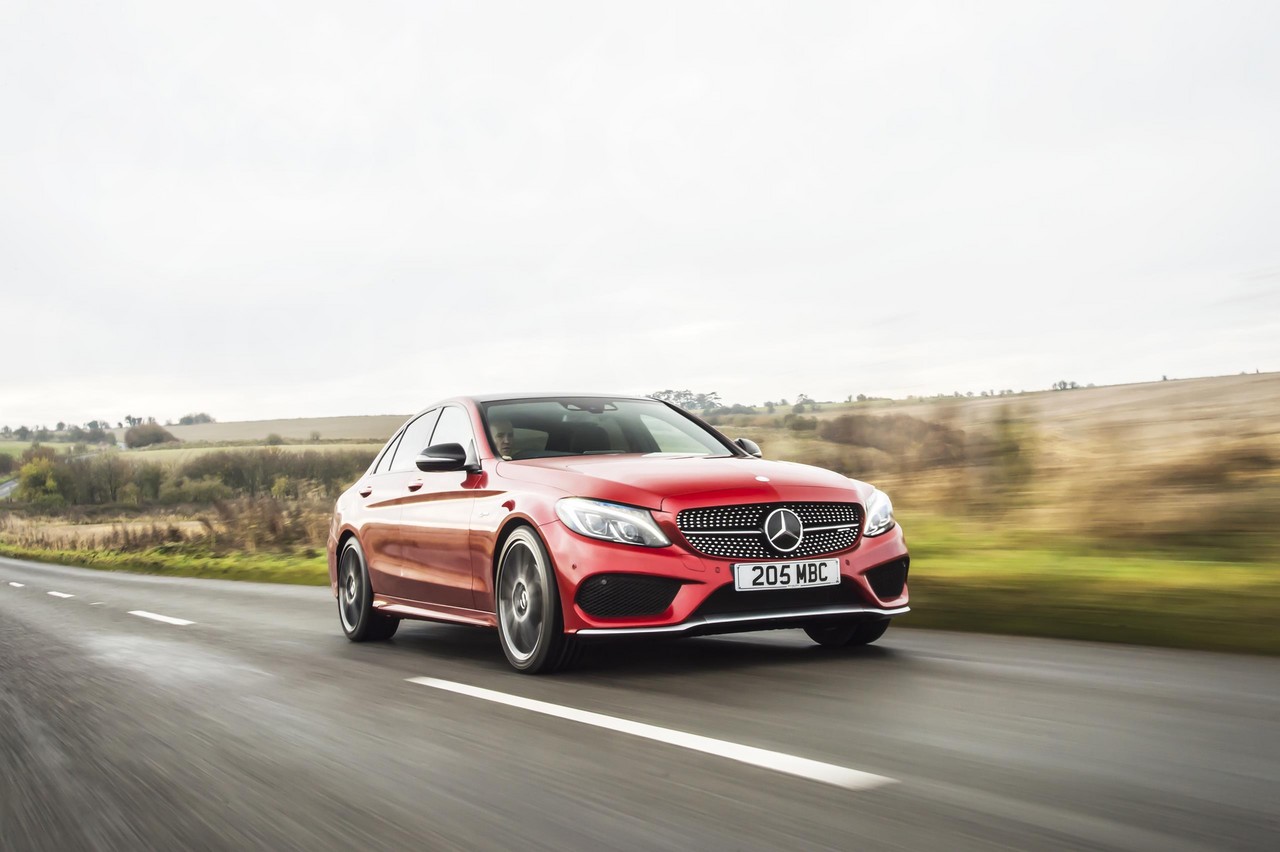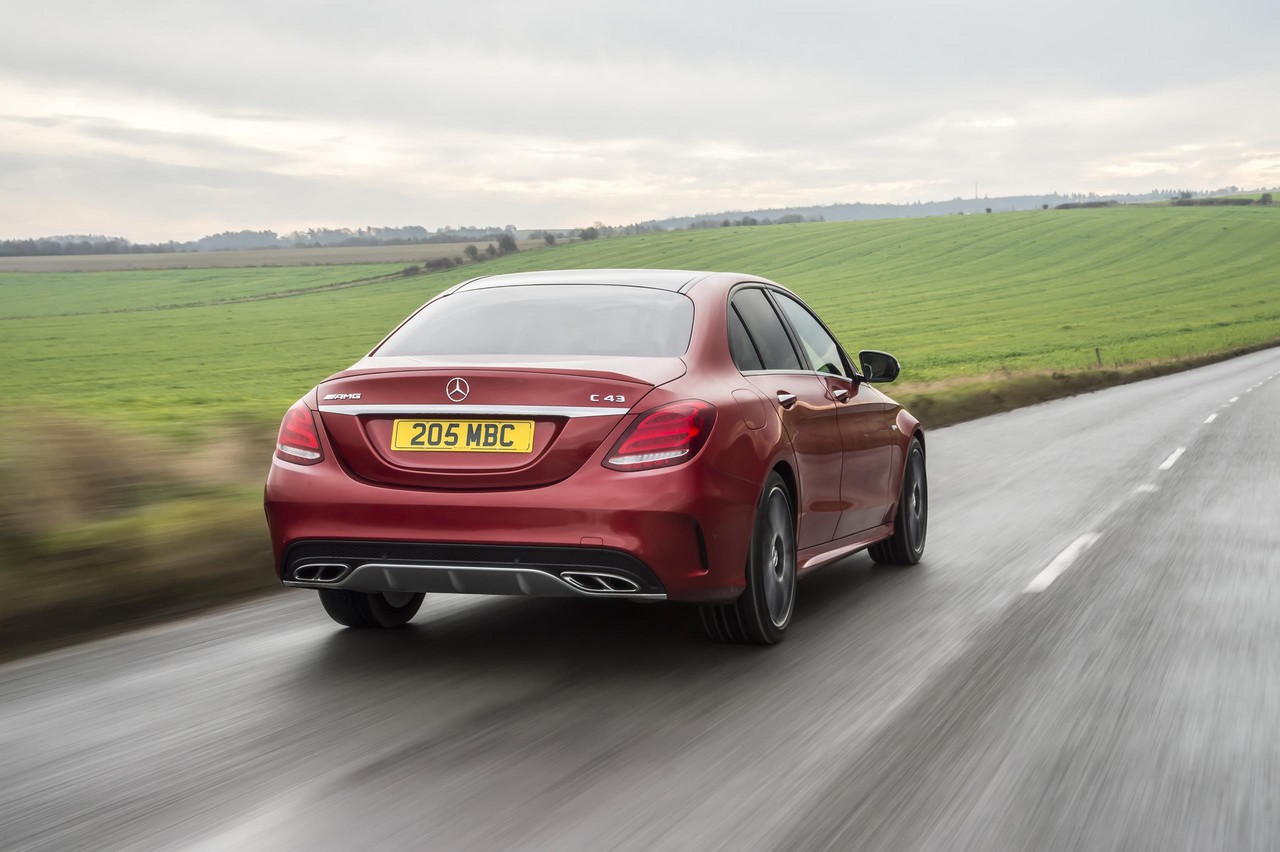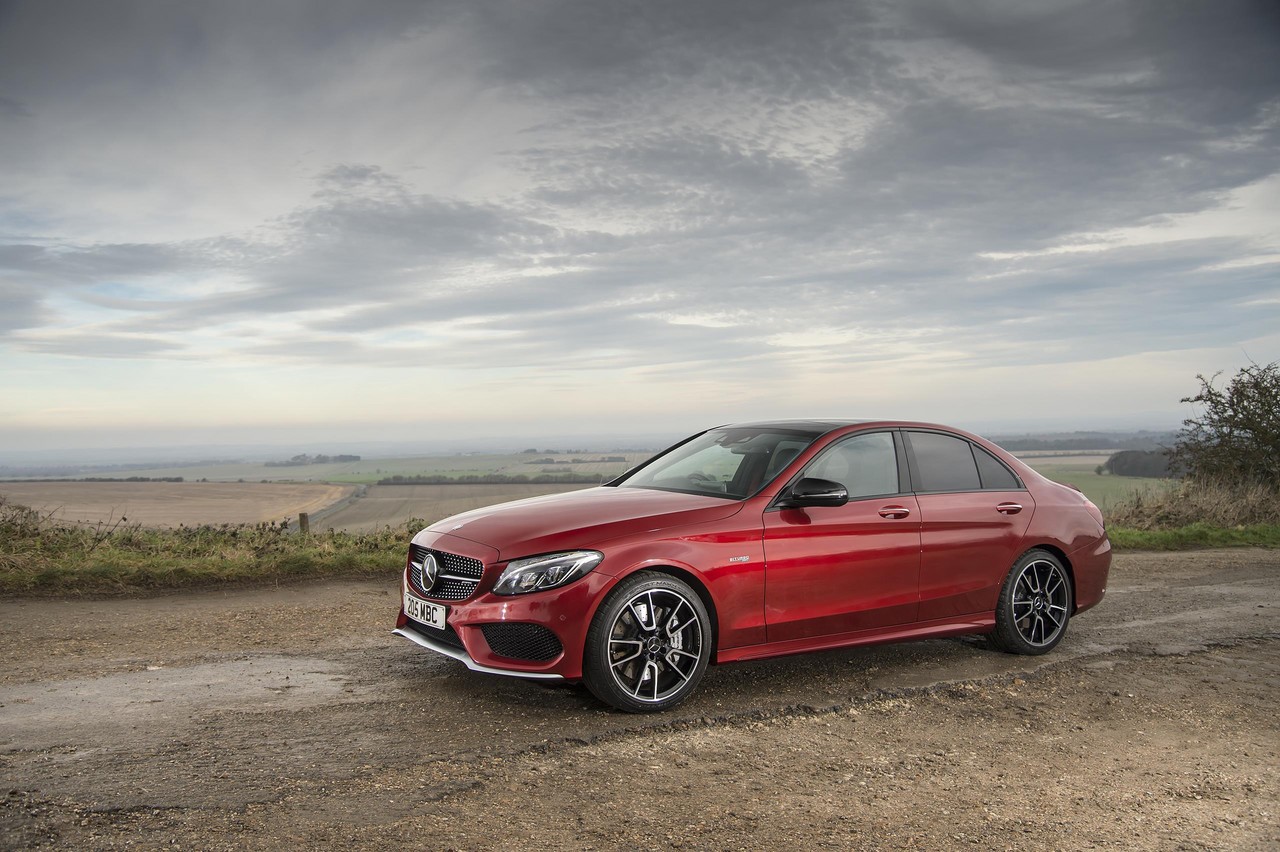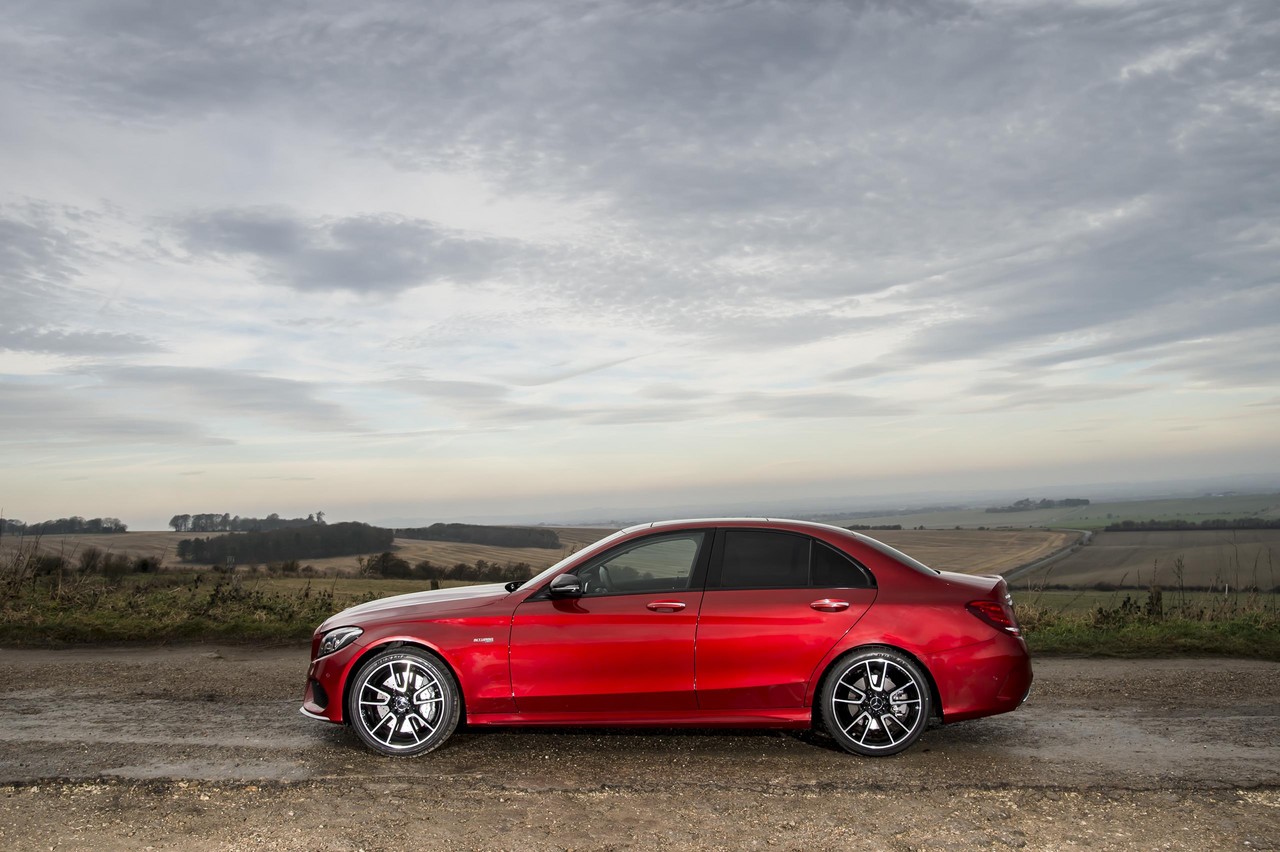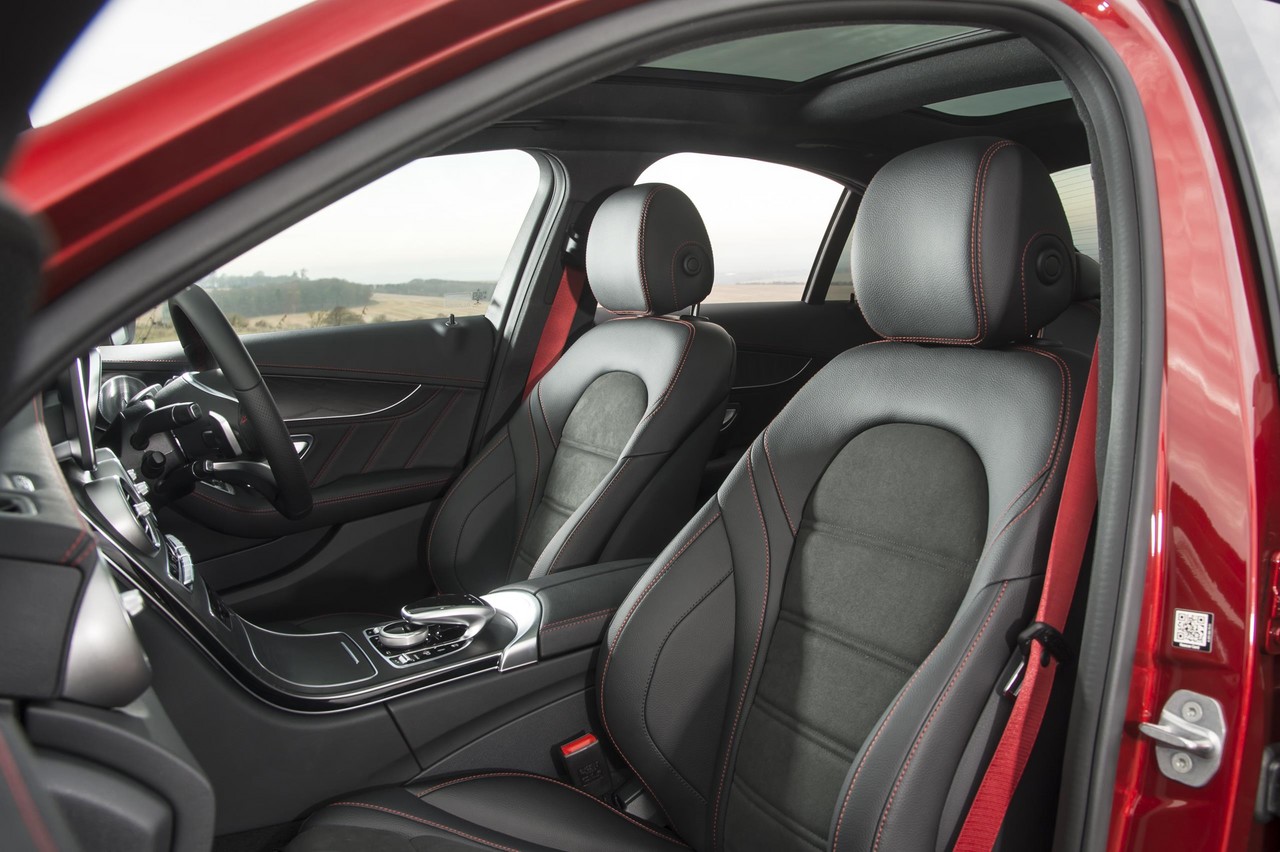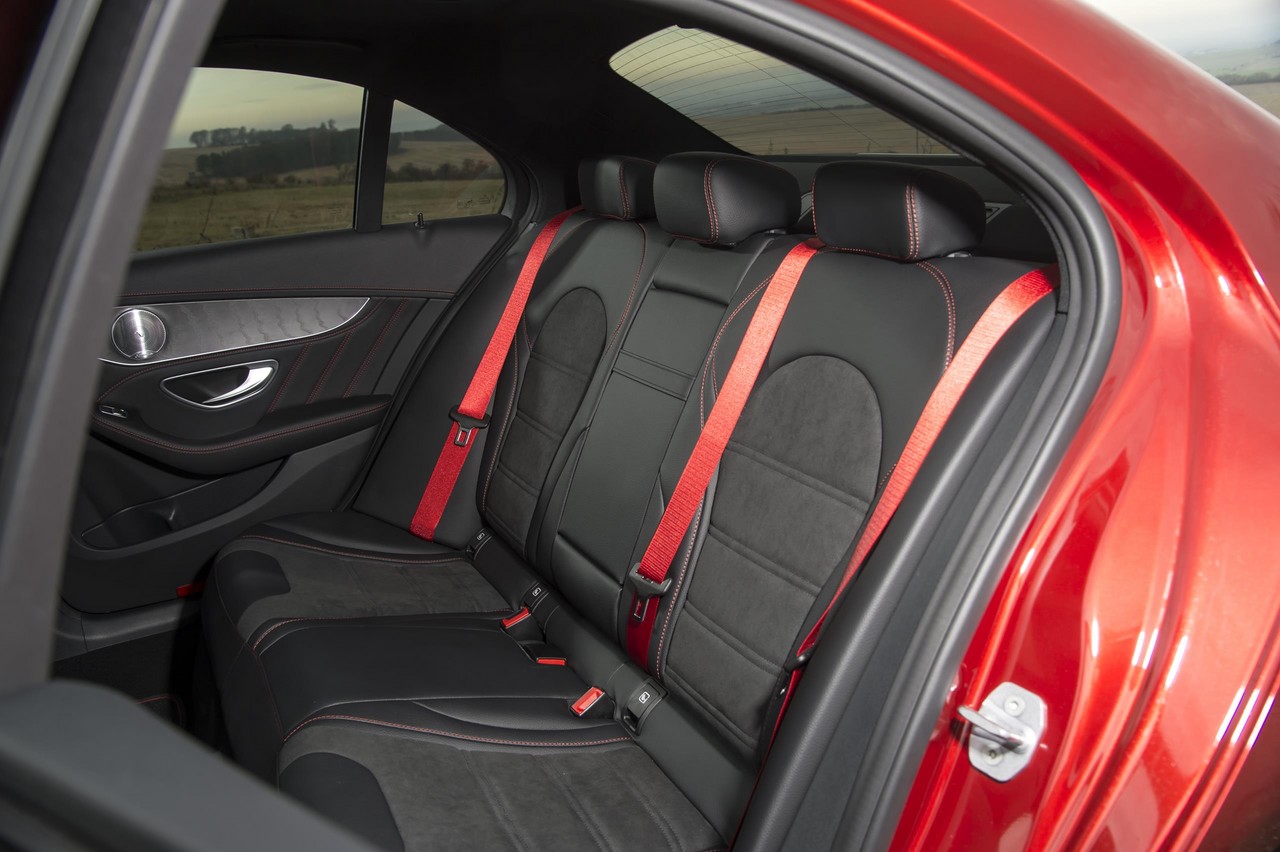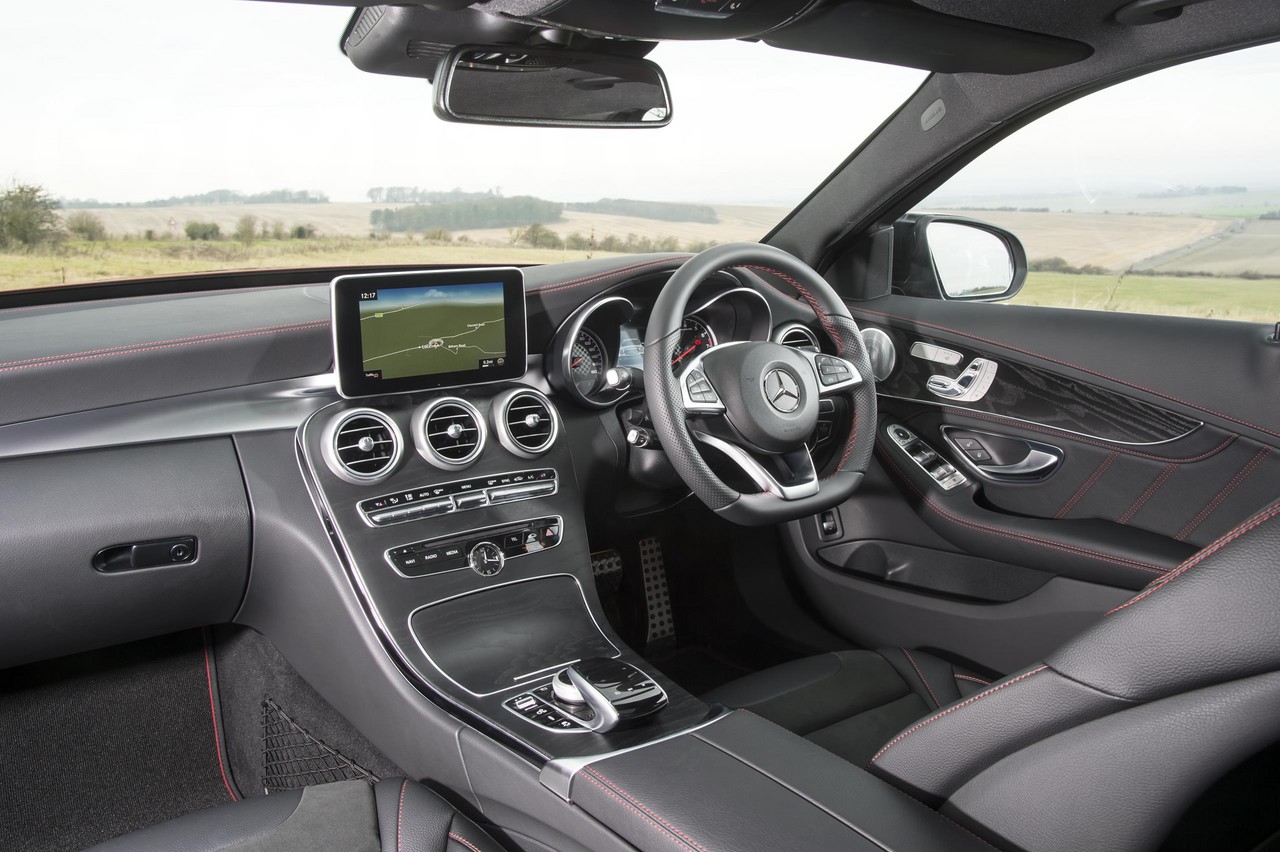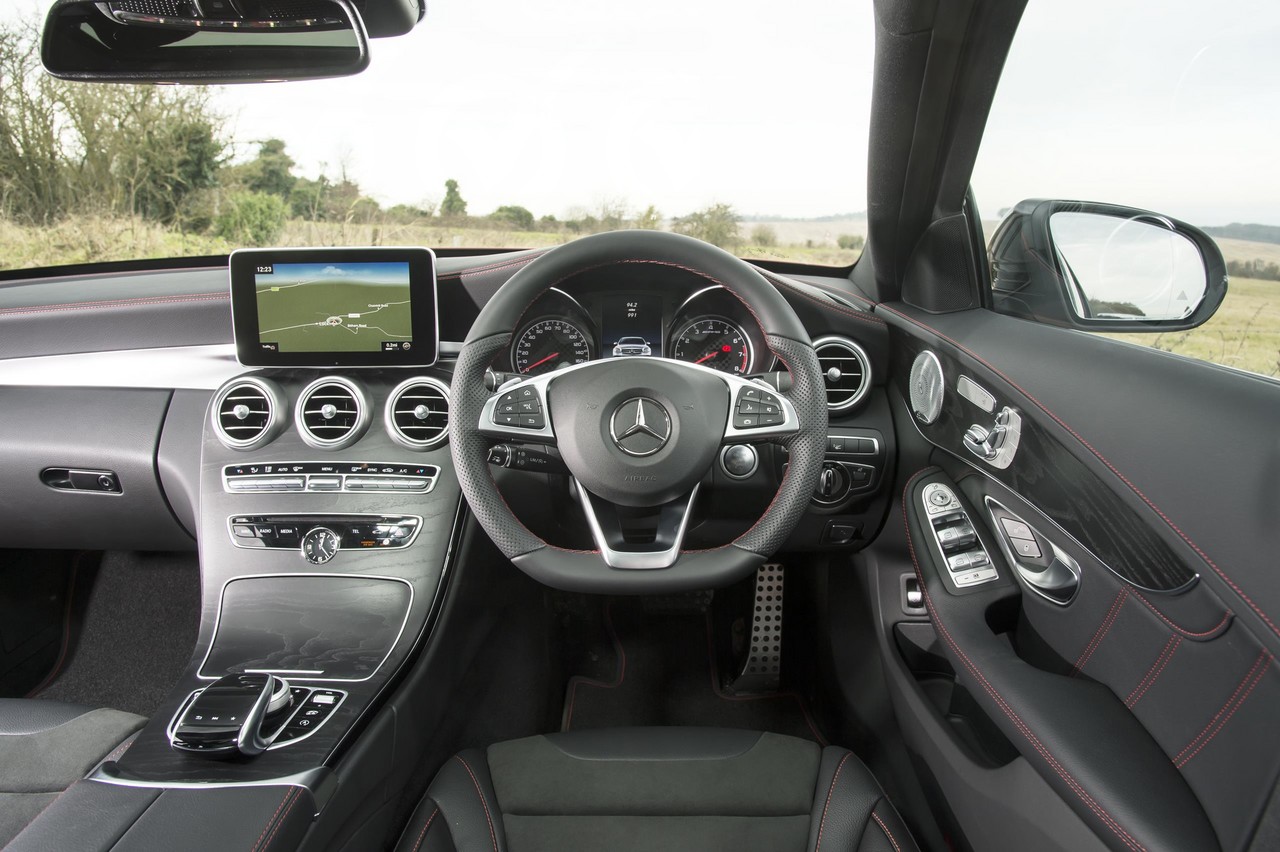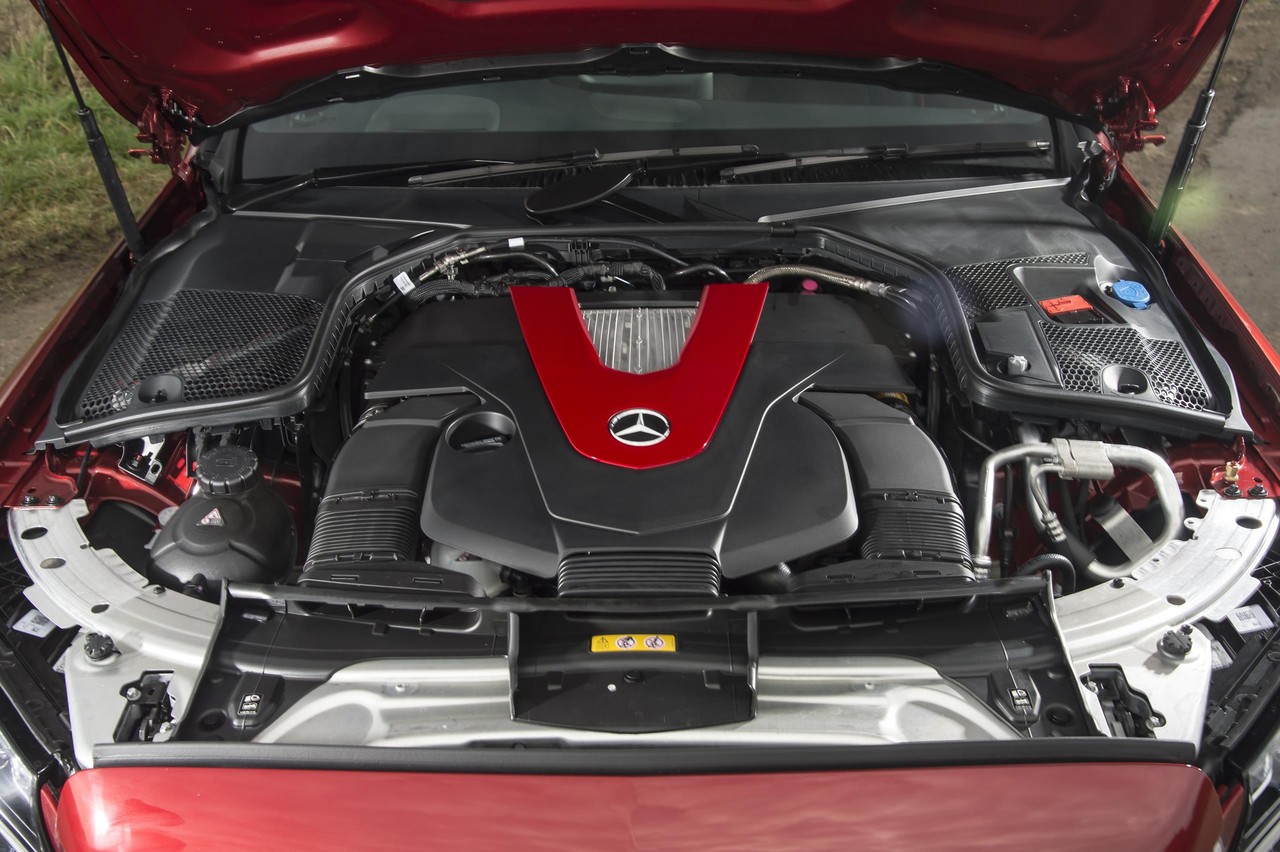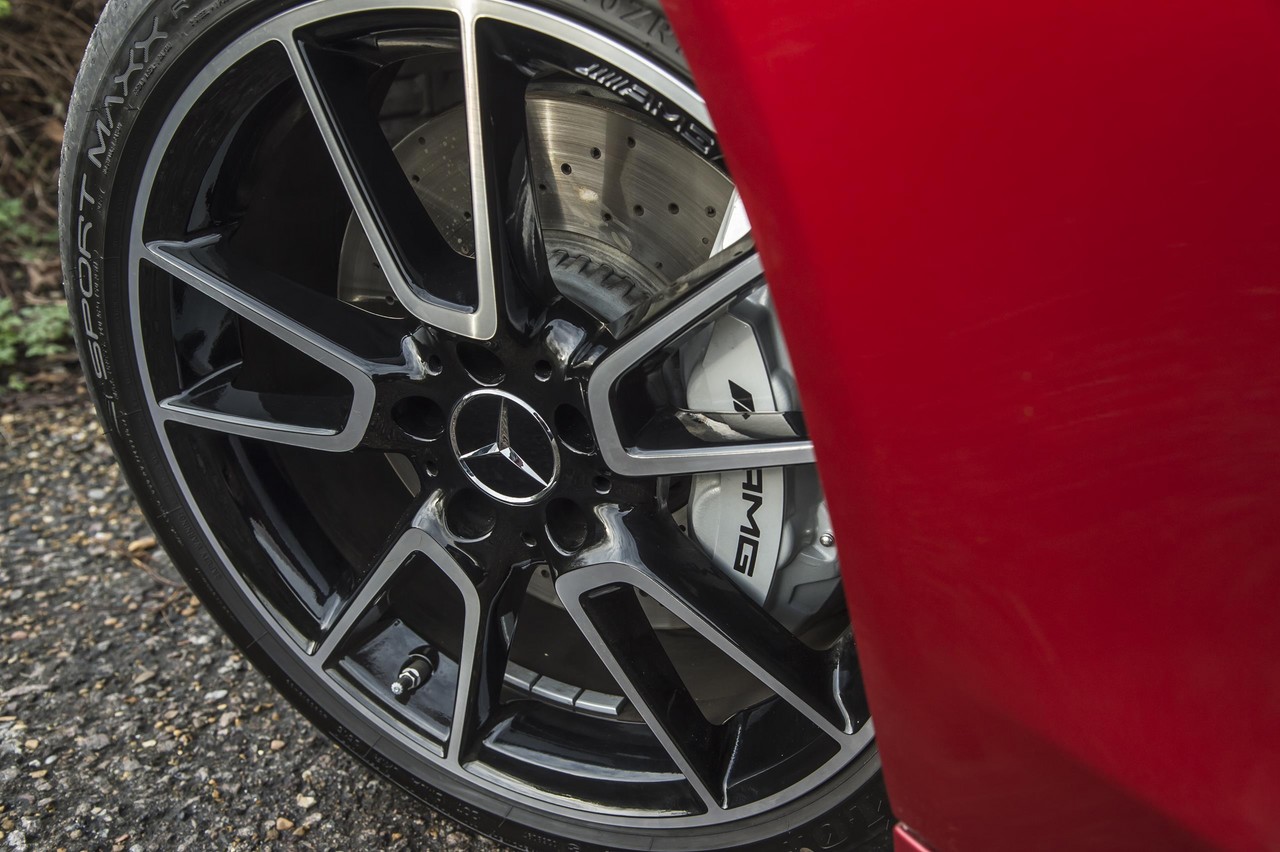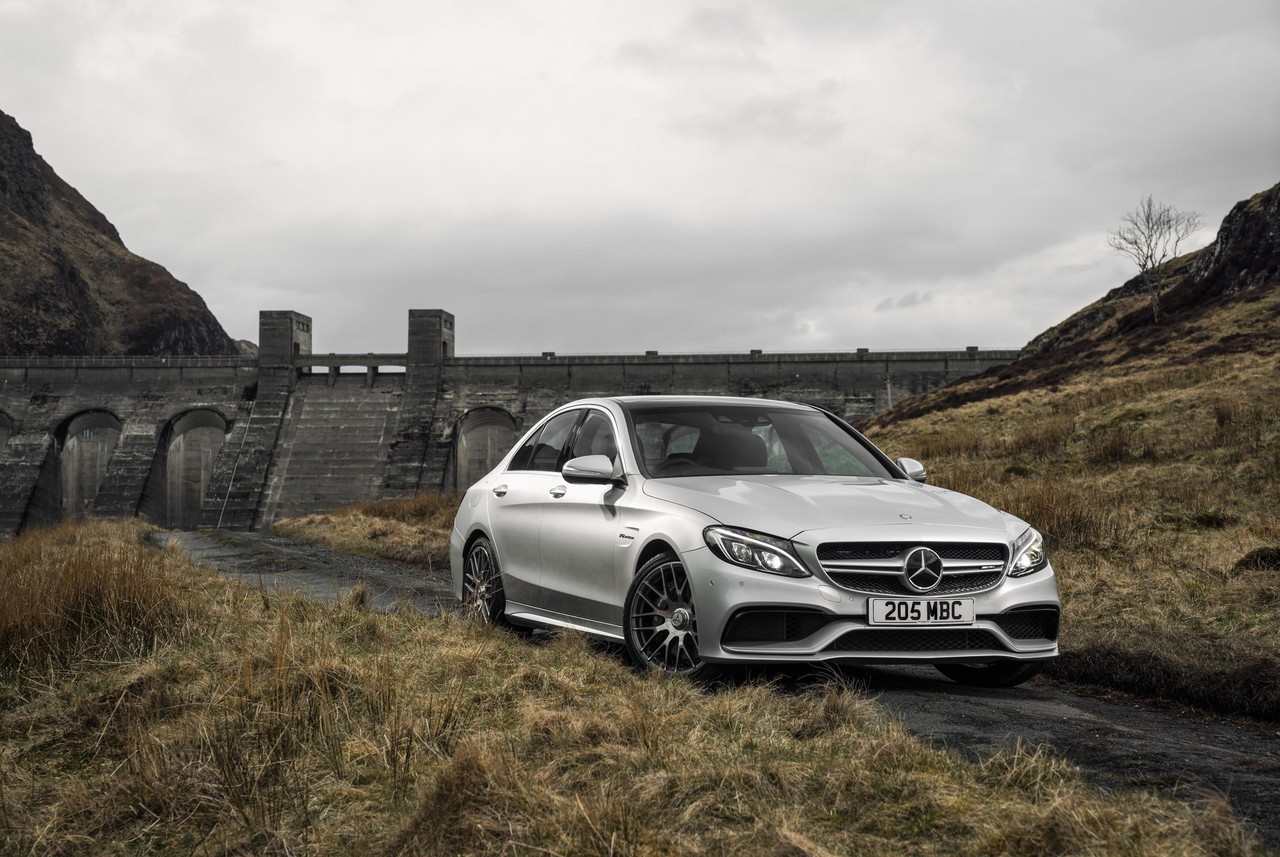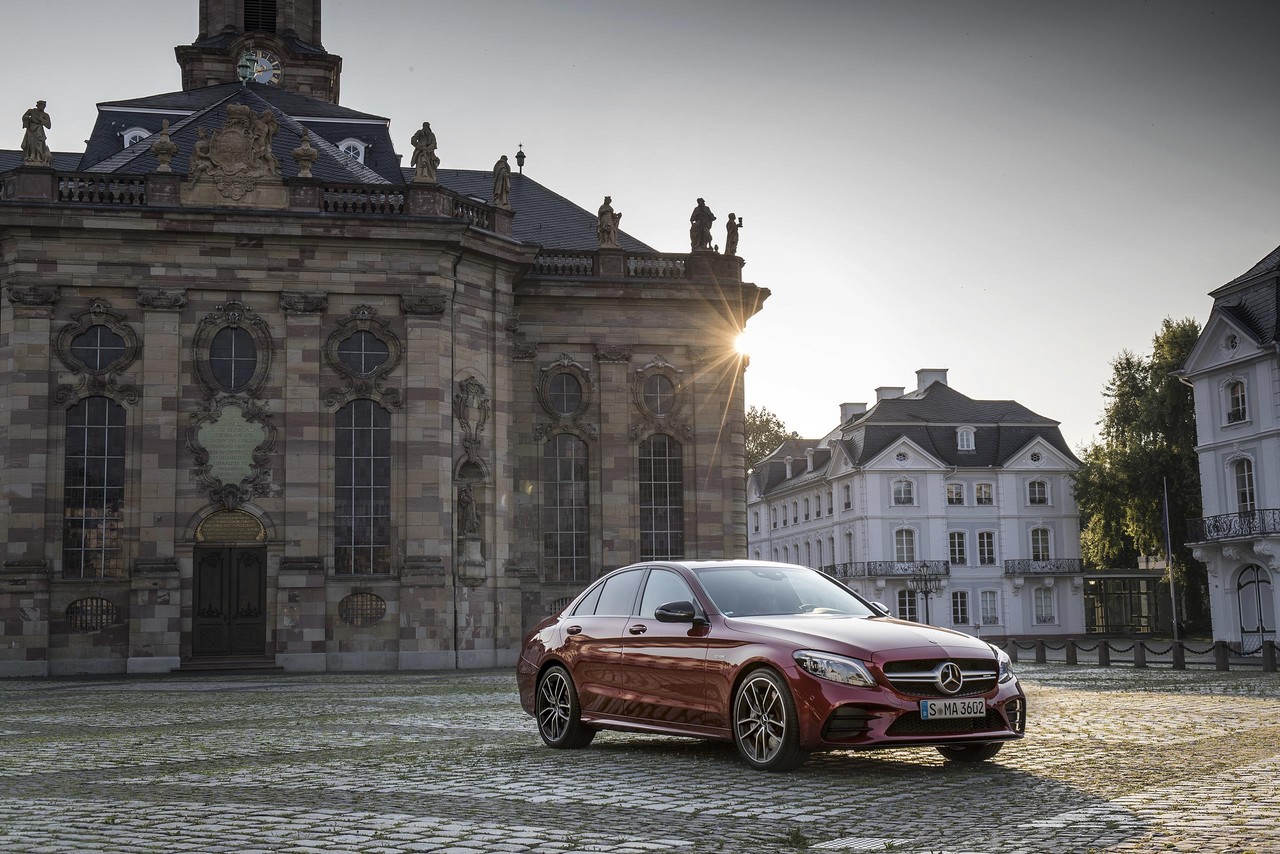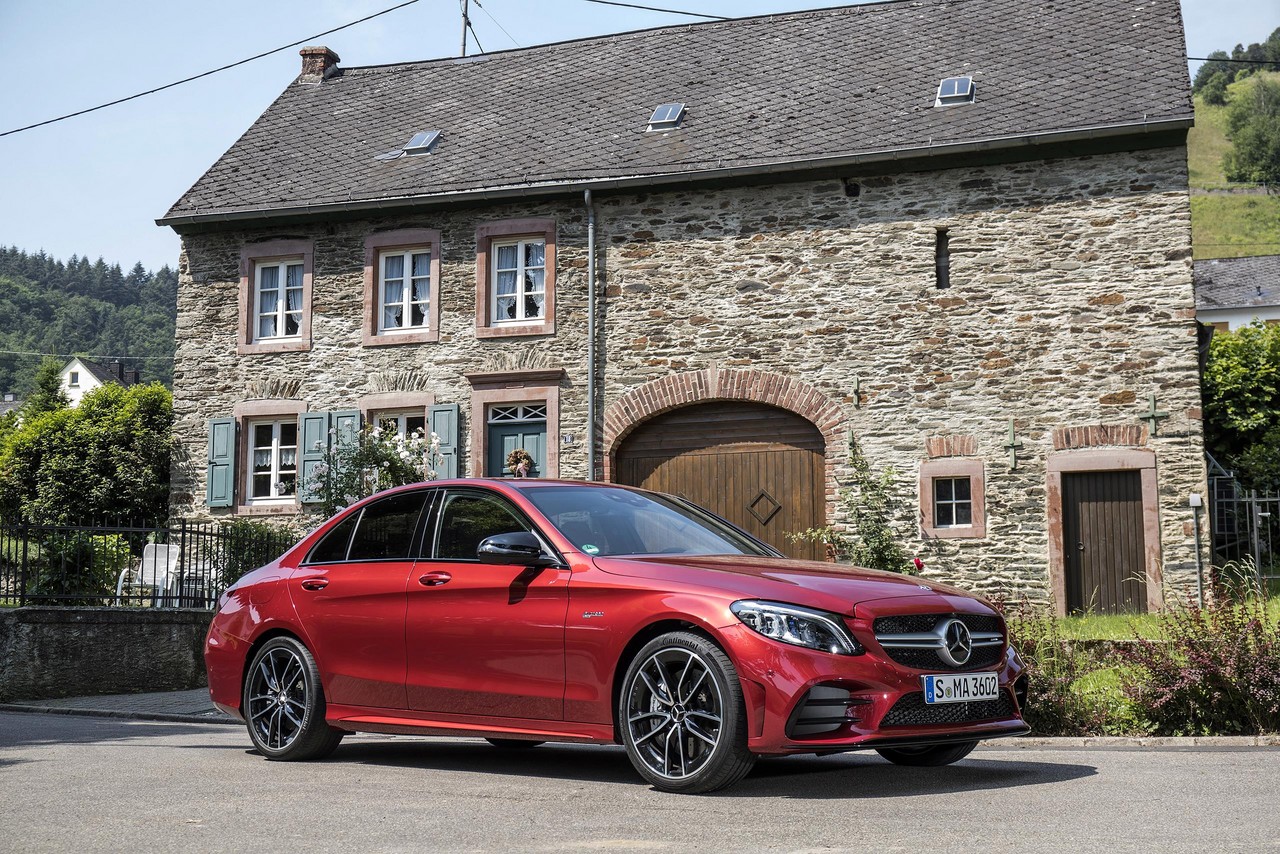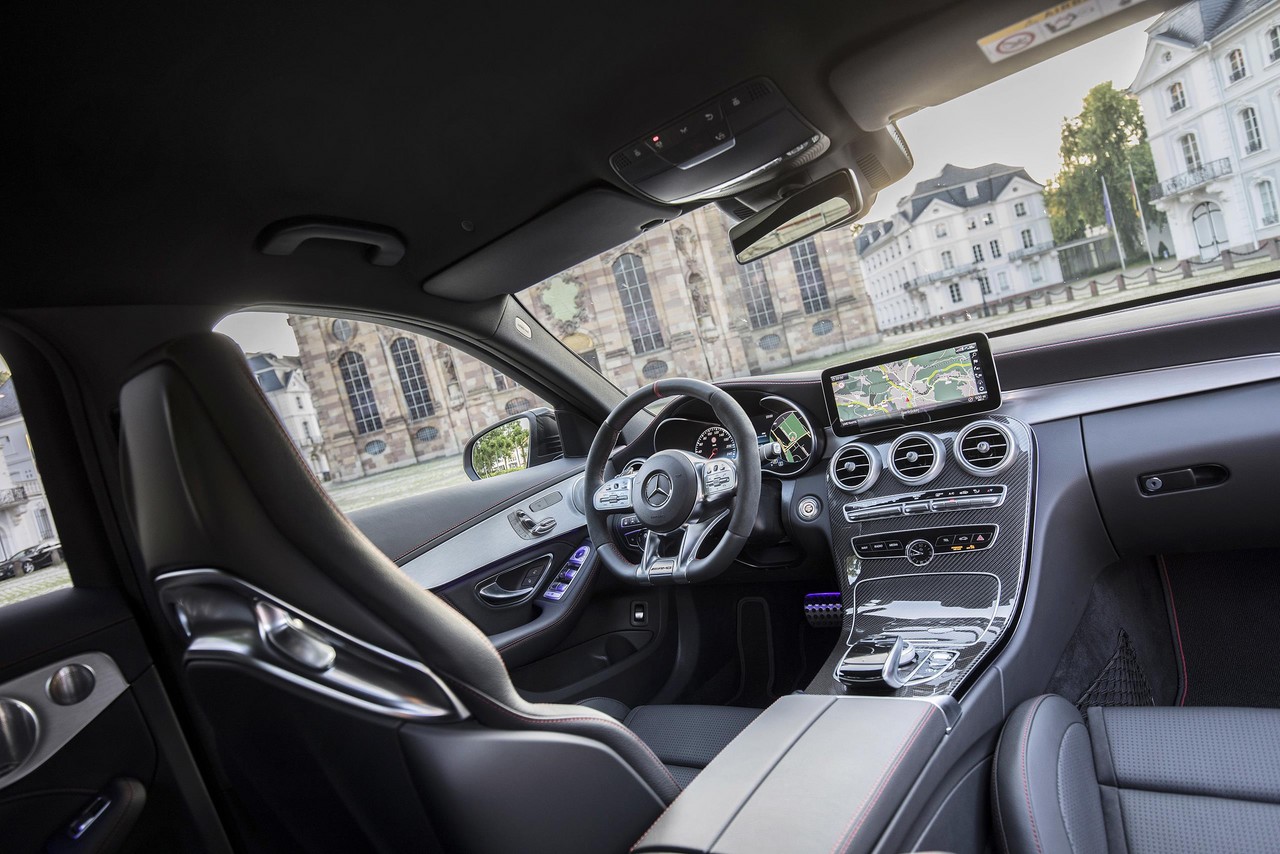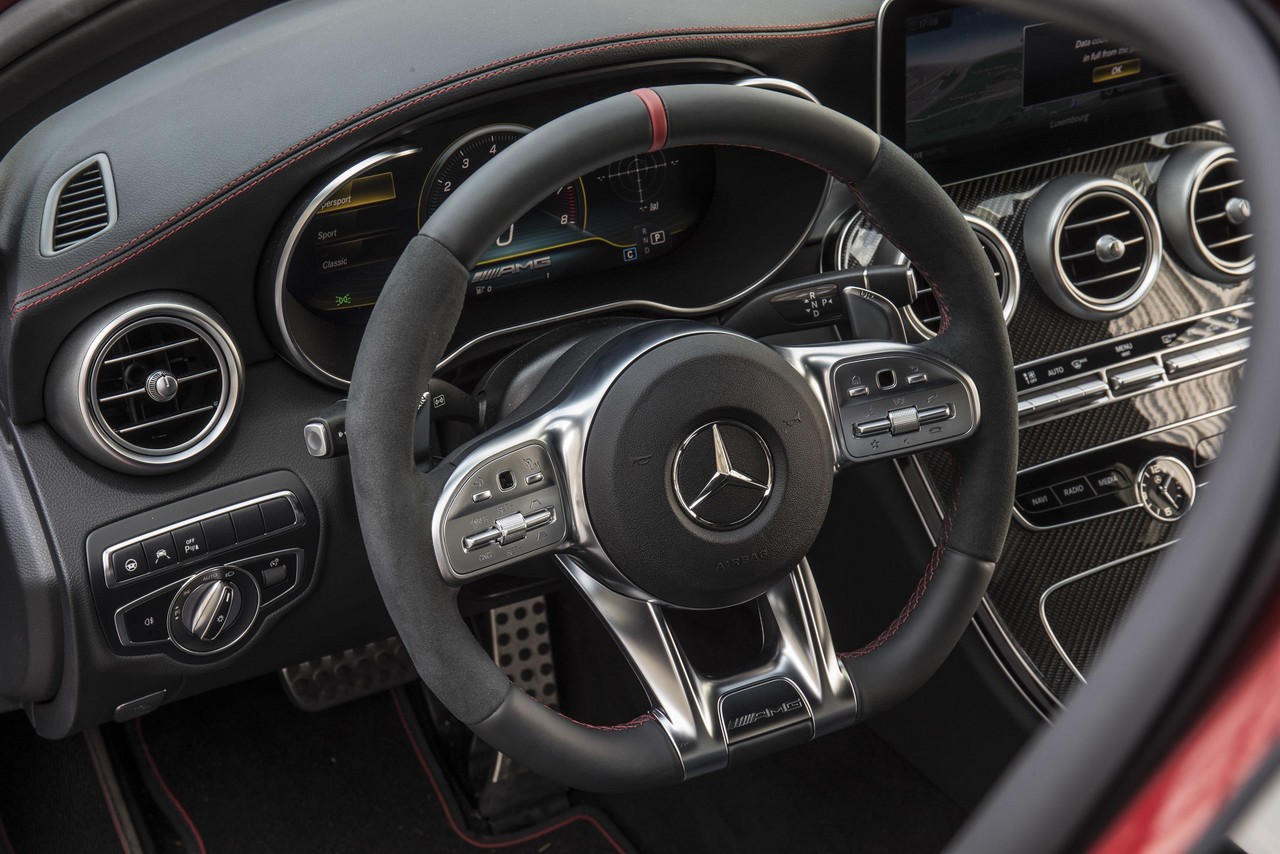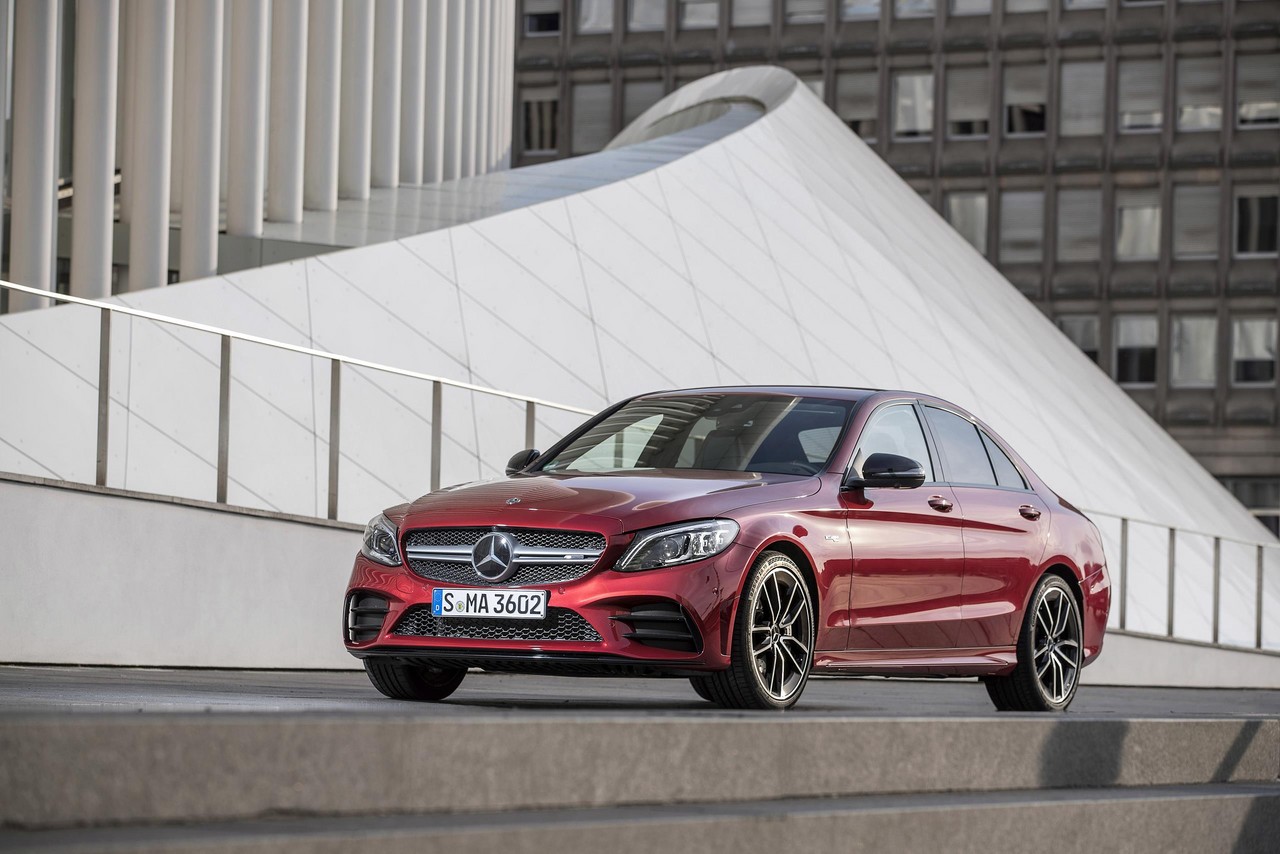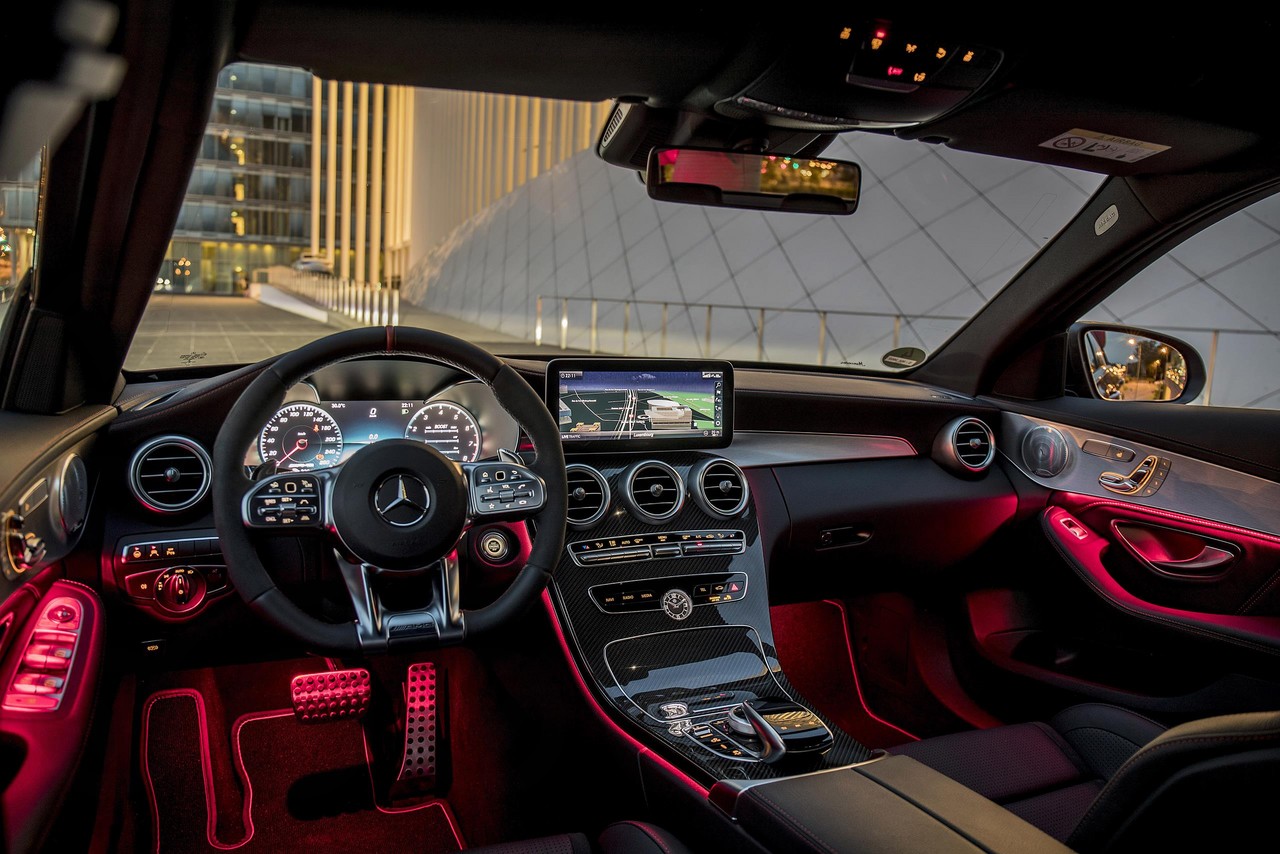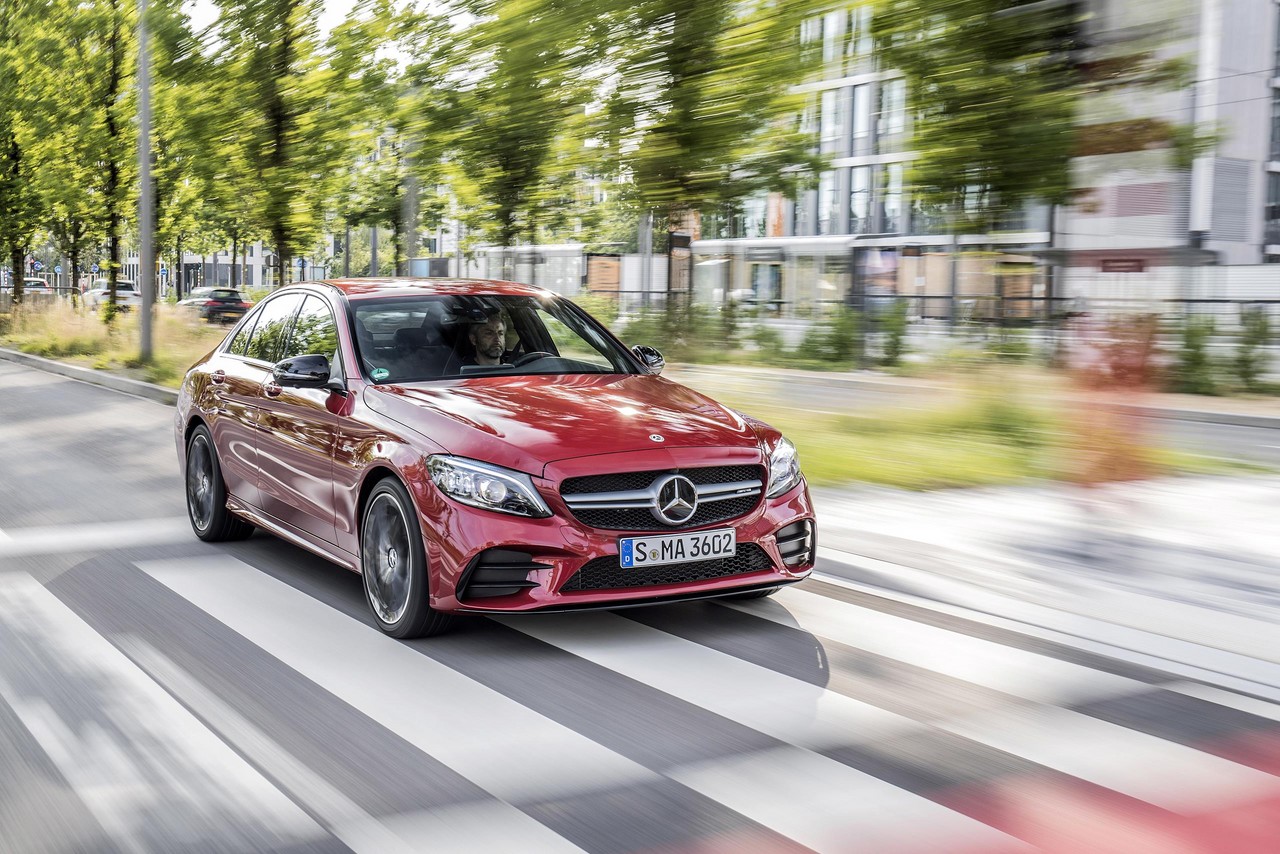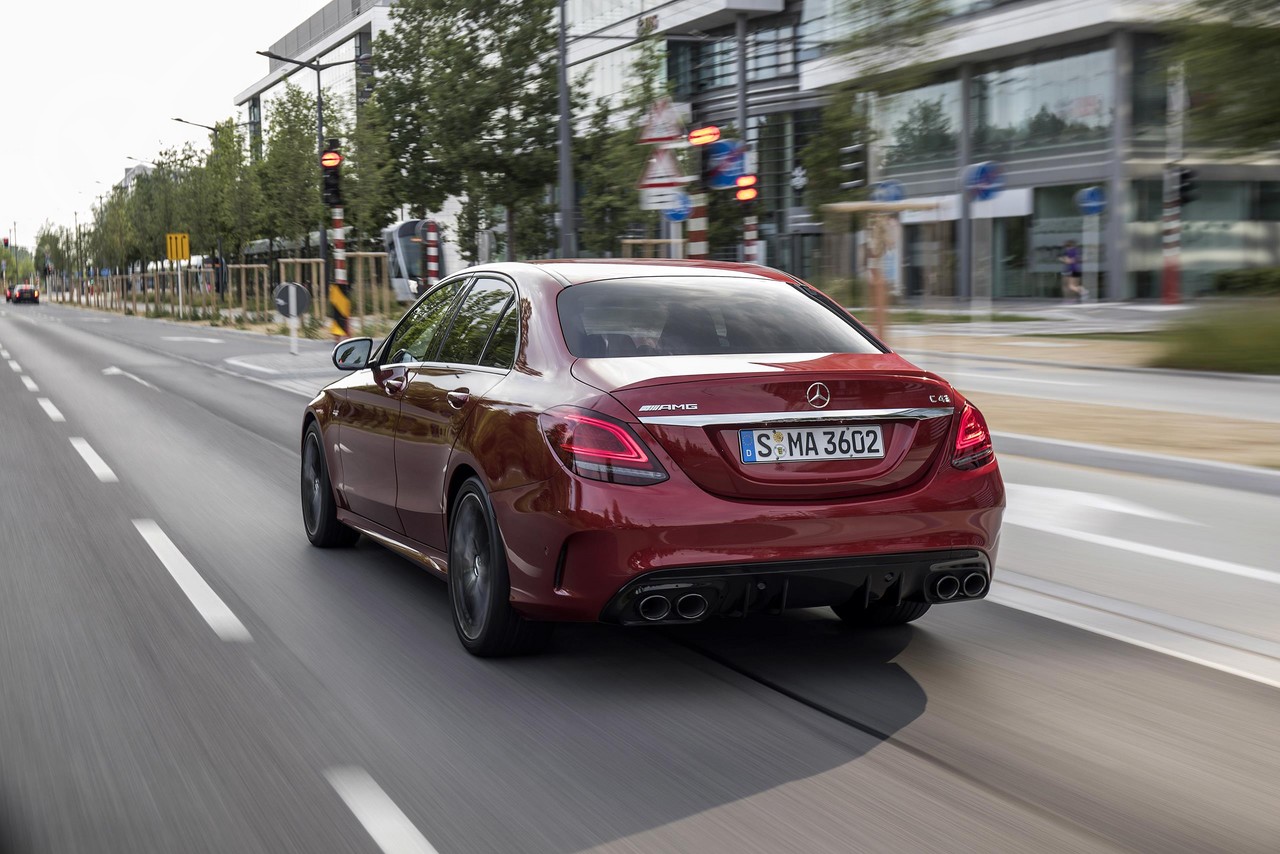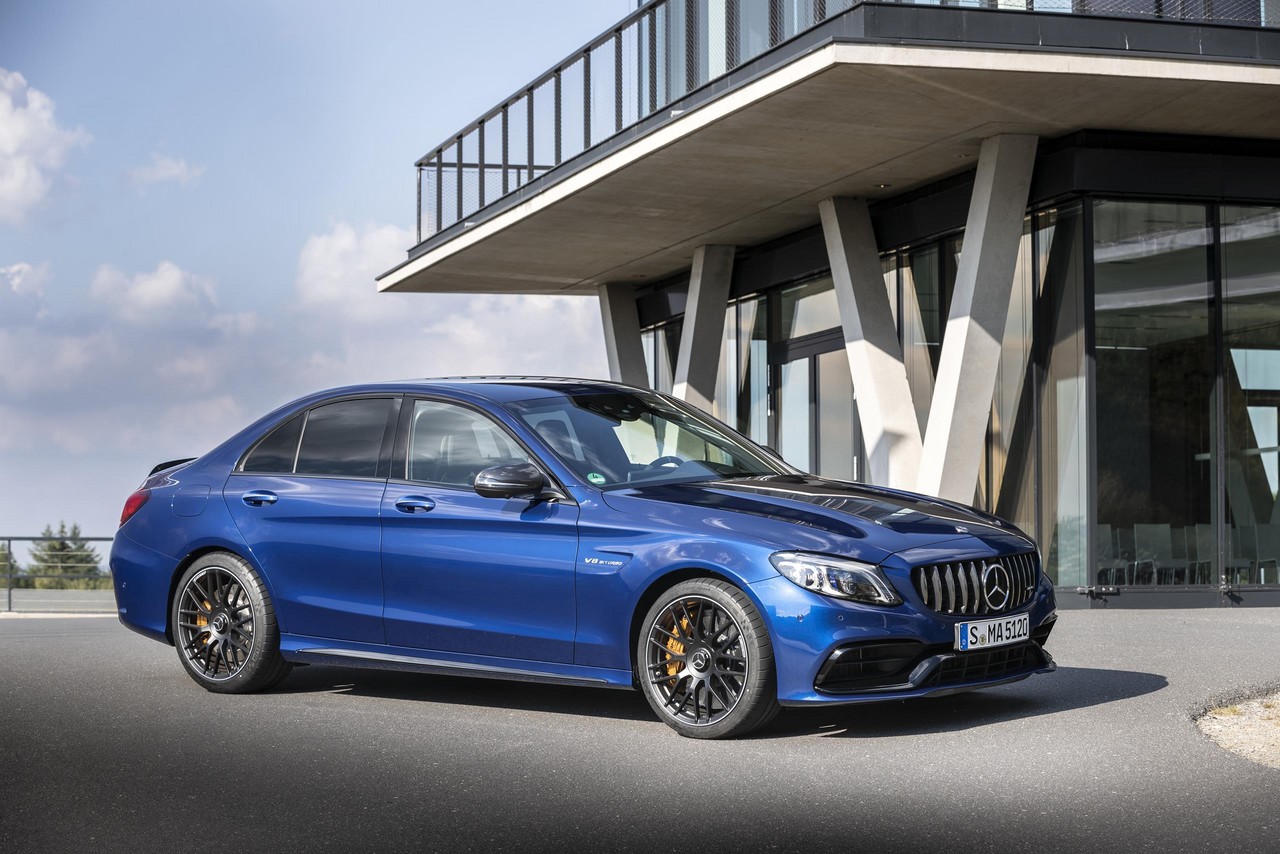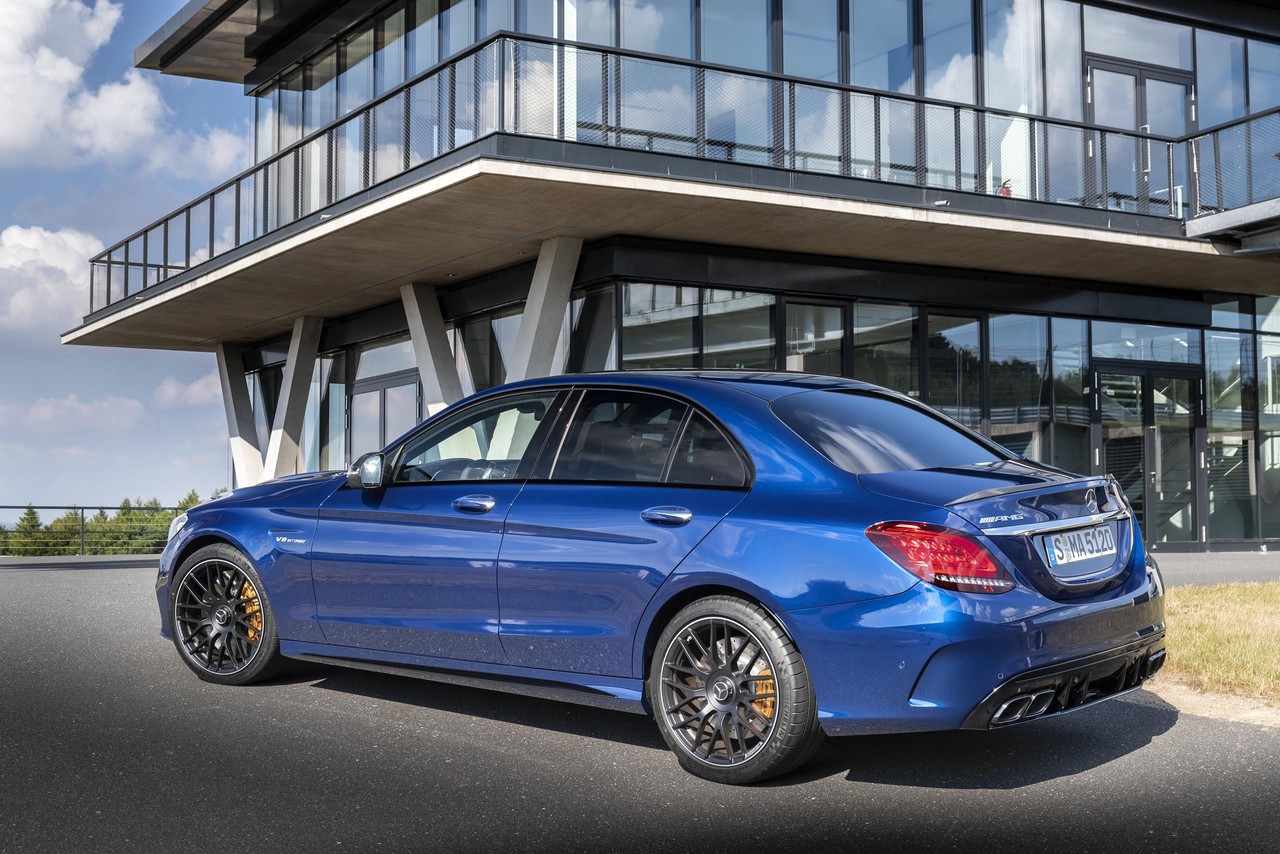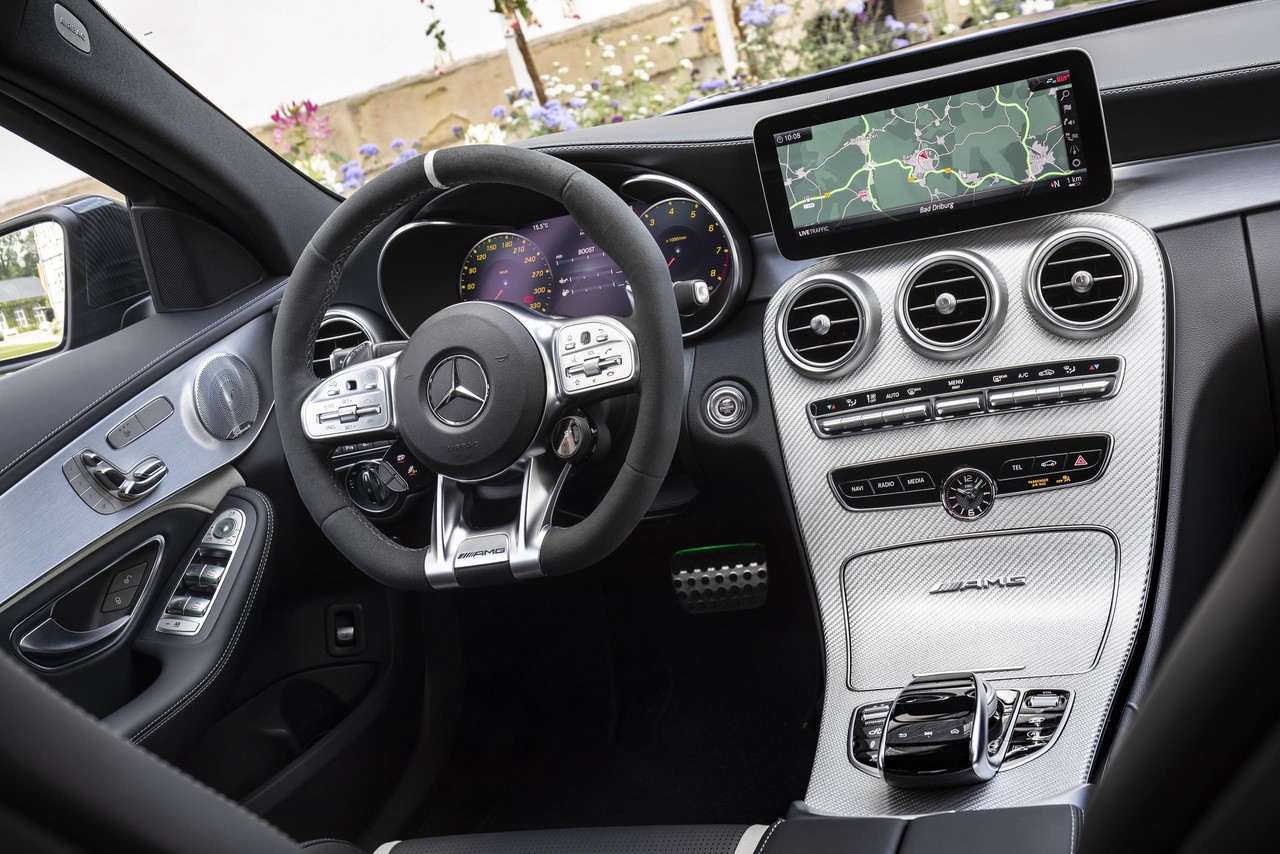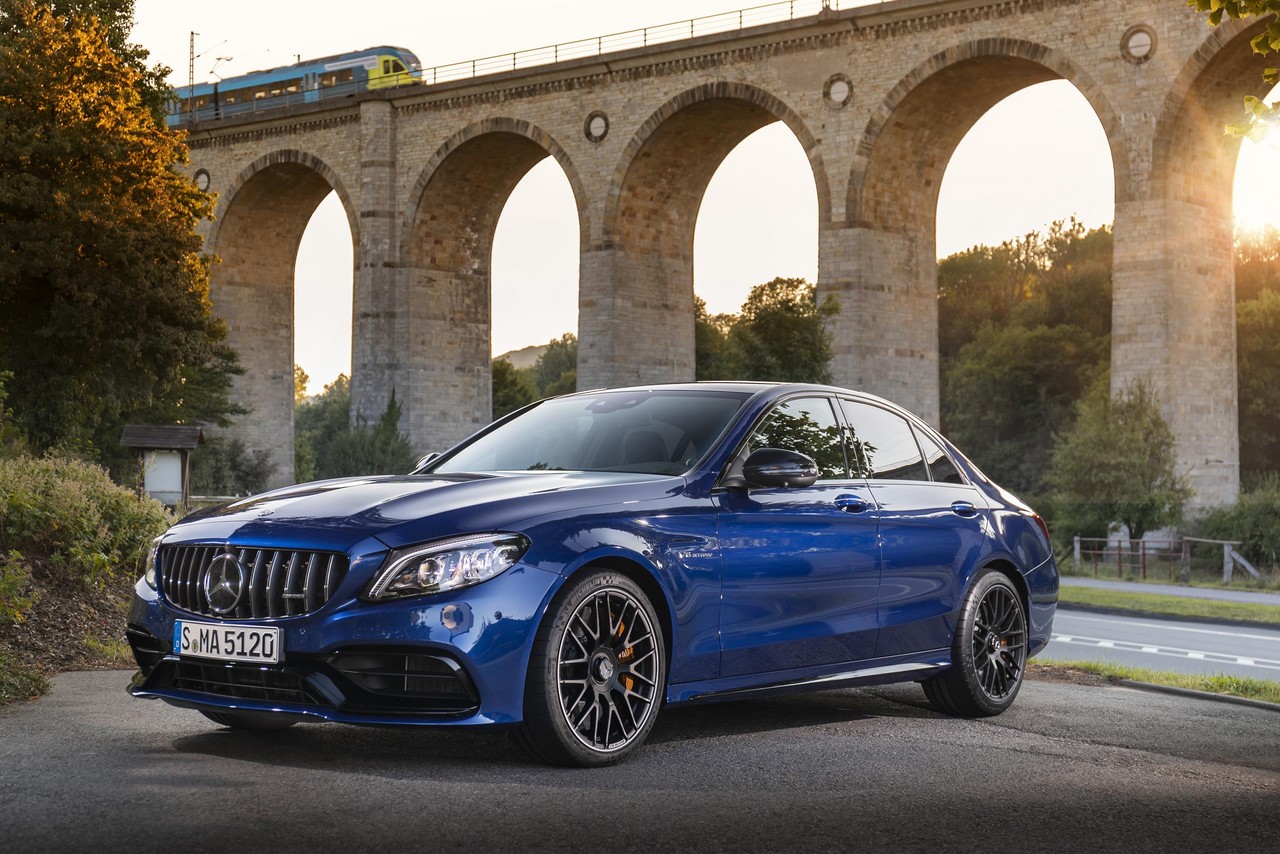
- For C 63 S, slight turbo lag at low rpm, firm ride, road noise and booming exhaust note in Sport mode
- For C 43, redline says 6500 rpm but limiter applies at 6000 rpm; Comfort mode lacks body control over bumps; lacks aural appeal of the C 63 S
- Road noise and, in Sport mode, booming exhaust note for rear passengers
Review: Mercedes-AMG W205.I C 43 & C 63 (2015-18)
Overview
The Mercedes-AMG W205 C 43 and C 63 S were high-performance sedans that were released in Australia in July 2016 and March 2015, respectively. Both manufactured in Bremen, Germany, the all-wheel drive C 43 was powered by a 3.0-litre biturbo V6 petrol engine and had a nine-speed automatic transmission, while the rear-wheel drive C 63 S was powered by a 4.0-litre biturbo V8 petrol engine and had a seven-speed double clutch transmission.
Biturbo M276 V6 engine
The Mercedes-AMG C 43 was powered by the 2996 cc M276.823 V6 engine which had an aluminium alloy block and cylinder head, ‘Nanoslide’ cylinder wall coatings, a forged steel crankshaft, an IHI turbocharger for each cylinder bank which provided peak boost pressure of 1.1 bar, double overhead camshafts (chain-driven), independent intake and exhaust camshaft adjustment, four valves per cylinder, direct injection via piezo injectors at a pressure of up to 200 bar, a variable-resonance intake manifold and a compression ratio of 10.7:1.
To reduce fuel consumption, the M276 engine had an ECO start/stop function which enabled it to shut down when the C 43 was stationary in traffic. Furthermore, the C 43 Coupe could accelerate from rest to 100 km/h in 4.7 seconds and had an electronically limited top speed of 250 km/h.
M177 V8 engine
Assembled by hand in Affalterbach, the 4.0-litre M177 V8 engine for the C 63 S had a cast aluminium closed-deck block, ‘Nanoslide’ cylinder wall coatings, zirconium alloy cylinder heads, two turbochargers mounted within the engine’s ‘V’ providing maximum boost pressure of 1.2 bar (17.4 psi), double overhead camshafts, variable inlet and exhaust valve timing, four valves per cylinder, direct fuel injection via piezo injectors, a compression ratio of 10.5:1 and dry sump lubrication. With its ‘Race Start’ function, the W205 C 63 S can accelerate from rest to 100 km/h in 3.9 seconds; maximum engine speed was 7000 rpm.
Like the biturbo M276 engine, the M177 V8 engine had an ‘ECO start/stop’ function. Furthermore, the clutch of the AMG Speedshift transmission could open when the ‘Comfort’ drive mode was selected to decouple the engine from the drivetrain if the driver lifted their foot off the accelerator at speeds between 60 km/h and 160 km/h. Over the combined ADR 81/02 test cycle, fuel consumption for the C 63 S was 8.7 litres per 100 km.
Like the Mercedes-AMG C190 GT , the C 63 S was fitted with dynamic engine mounts which could adapt their stiffness according to driving conditions and style. As such, softer mounts were used to improve comfort by reducing noise and vibration.
| Model | Drive | Engine | Trans. | Peak power | Peak torque |
|---|---|---|---|---|---|
| C 43 | AWD | 3.0-litre M276.823 biturbo petrol V6 | 9sp auto | 270 kW at 5500-6000 rpm | 520 Nm at 2000-4200 rpm |
| C 63 S | RWD | 4.0-litre M177.980 biturbo petrol V8 | 7sp DCT | 375 kW at 5500-6250 rpm | 700 Nm at 1750-4500 rpm |
C 43: 4MATIC all-wheel drive system and 9G-Tronic transmission
For the Mercedes-AMG C 43, the ‘4MATIC’ all-wheel drive system utilised a centre planetary differential and multiple-disc clutch, with the single-stage transfer case flange-mounted on the nine-speed ‘9G Tronic’ automatic transmission. In normal conditions, the 4MATIC system provided a 31:69 front:rear torque split.
For the C 43, Mercedes developed unique software for the 9G-Tronic transmission to deliver faster gearshifts. The transmission had a multiple downshift function and the driver could select from Eco, Comfort, Sport, Sport Plus and Manual modes for different transmission gearshift mapping and shift speeds. In ‘Eco’ mode, the clutch could disengage to decouple the engine from the powertrain when the driver released the accelerator and the C 43 was travelling between 60 km/h and 160 km/h; when this occurred, engine speed was reduced to idle and the driving resistance was reduced by the compression and frictional forces of the engine in over-run mode.
In the ‘Sport’ and ‘Sport Plus’ modes, the 9G-Tronic transmission provided:
- A double-declutching function; and,
- Ignition adjustments for faster gearshifts.
In Manual mode, the driver could change gear using the paddles on the steering wheel and the transmission would stay in the selected gear until engine speed reached its rpm limit.
C 63 S: AMG Speedshift dual clutch transmission
For the W205 C 63 S, the seven-speed ‘AMG SPEEDSHIFT’ dual clutch transmission enabled the driver to select the following modes:
- Comfort: for ‘soft’ gearshifts and a ‘more restrained engine sound’. In Comfort, the clutch of the transmission opened to decouple the engine from the drivetrain if the driver lifted off the accelerator at speeds between 60 km/h and 160 km/h. In Comfort mode, the electronically-controlled dampers provided softer settings and power steering assistance was increased;
- Sport: provided faster gearshifts, greater throttle response and stiffer suspension settings;
- Sport +: provided greater throttle response, increased idle speed to 800 rpm (from 600 rpm), and enabled the adjustable exhaust flaps to open sooner. The transmission also provided faster gearshifts, double declutching and partial cylinder suppression under full throttle by retarding ignition and injection under full throttle for even faster gearshifts. In Sport +, the ECO stop/start and ‘sailing’ functions were disabled;
- Individual: enabled the driver to vary individual parameters for the engine, exhaust system, damper and transmission settings; and,
- Race: provided maximum throttle response, the transmission would maintain an optimum engine speed in the lowest possible gear when driving at racetrack speeds and the electronic stability control system allowed ‘wide drift angles’.
The driver could also engage ‘momentary M mode’ by nudging the ‘up’ or ‘down’ gearshift paddle once. In ‘momentary M mode’, the driver could use the gearshift paddles to change gears, while up and downshifts occurred at the rpm limits.
Chassis and dimensions
Like the Mercedes-Benz W205 C-Class , the chassis for the Mercedes-AMG W205 C 43 and C 63 combined aluminium, hot-formed steels and ultra-high strength steels, while the front wings, bonnet, boot lid, doors and roof panelling were made from aluminium to reduce mass. For the Mercedes-AMG models, however, specific areas of the body structure were reinforced to compensate for the longitudinal and transverse forces generated and transmitted by the drivetrain and running gear.
Compared to the W204 C 63 AMG , the W205 C 63 was 30 mm longer (at 4756 mm), 44 mm wider (1839 mm), 13 mm lower (1426 mm) and had a 75 mm longer wheelbase (2840 mm). Furthermore, the W205 C 63 had a kerb weight of 1655 kg (excluding the driver) and boot capacity was 435 litres. Relative to the W205 C 63 S, however, the C 43 was 42 mm shorter (at 4714 mm) and 29 mm narrower (1810 mm) since it omitted the flared wheel guards of the C 63.
Suspension
The Mercedes-AMG W205 C 43 and C 63 had four-link front suspension with independent steering knuckles and a wider track for greater stability, and five-link rear suspension with independent mounts and increased negative camber. The ‘AMG Ride Control’ suspension included electronically-controlled, three-stage adaptable Bilstein dampers which provided variable damping force according to road conditions, driver behaviour and the selected drive mode.
Steering
The Mercedes-AMG W205 C 43 and C 63 S had rack-and-pinion steering with variable, electric power assistance; the steering ratio was 14.1:1, while the turning circle was 11.3 metres.
Safety equipment
Standard safety equipment for the Mercedes-AMG W205 C 43 and C 63 S included dual front airbags, a driver’s knee airbag, front and rear side airbags, full-length curtain airbags, ABS, electronic brake force distribution, brake assist, electronic stability control, traction control and front seatbelts with pre-tensioners and load limiters.
As standard, the W205 C 43 and C 63 S was also fitted with:
- Pre-Safe Brake with pedestrian detection (autonomous emergency braking): using two 24 GHz sensors behind the front bumper which had a range of 30 metres and a 77 GHz radar which had a range of 200 metres, Pre-Safe Brake operated at speeds between 30 km/h and 200 km/h, and at speeds below 70 km/h if the vehicle was approaching a stationary queue of traffic. Around 2.6 seconds before the anticipated moment of impact, an audible warning would sound and a red warning would appear in the tachometer. Around 1.6 before the calculated impact, the first stage of Pre-Safe Brake would initiate partial braking autonomously with around 40 per cent of the maximum braking power (approximately four (4) m/s2); the Pre-Safe occupant protections system would also be activated. If the driver then applied the brakes, maximum braking force would be made available. If the driver failed to react, Pre-Safe Brake would – in its second stage – initiate autonomous emergency braking (i.e. maximum braking power) around 0.6 seconds before the unavoidable collision to reduce the severity of the impact. The pedestrian recognition function enabled Pre-Safe Brake to detect pedestrians when driving at speeds of up to 50 km/h;
- Pre-Safe Plus: could anticipate potential rear-end collisions and warn following traffic by flashing the rear hazard lights at high frequency. The Pre-Safe Plus system would then deploy occupant protection measures and apply the vehicle’s brakes to prevent secondary accidents;
- BAS Plus with Cross-Traffic Assist: used a 24 GHz radar sensor with a range of 30 metres to monitor the distance to the vehicle ahead and would warn the driver if there was a risk of a collision. Significantly, Brake Assist Plus could calculate the necessary brake force assistance to prevent a rear-end collision, build up that pressure in the braking system and provide it as soon as the brake pedal was depressed for ‘the best possible deceleration’. Using the stereo camera and radar sensors, the Cross-Traffic Assist function could detect traffic that was crossing in front of or behind the vehicle and alert the driver;
- Pre-Safe: in dangerous driving situations, Pre-Safe would prepare the vehicle by tensioning the front seat belts, closing the windows and sunroof (where fitted);
- Collision Prevention Assist Plus (radar-based collision warning with autonomous braking and adaptive Brake Assist): used radar sensors to monitor the distance to the vehicle ahead. If this distance decreased such that there was a risk of a collision, the driver would receive a visual warning (when driving at speeds over 7 km/h) and an optical warning (when driving between 30 km/h and 250 km/h). At speeds below 105 km/h (200 km/h in conjunction with Distronic Plus), Collision Prevention Assist Plus would initially provide partial autonomous braking to reduce vehicle speed and alert the driver. At speeds between 7-250 km/h for moving objects and 7-50 km/h for stationary objects, adaptive Brake Assist would calculate the braking force required and prime the braking system for when the driver depressed the brake pedal. If the driver did not respond and a collision was unavoidable, then maximum braking force would be applied to reduce vehicle speed. At initial vehicle speeds of up to 40 km/h, rear-end collisions could be prevented;
- Distronic Plus (adaptive cruise control with brake warning): an ‘adaptive’ cruise control system which used two short-range radar sensors positioned behind the front bumper to monitor the road up to 30 metres ahead, and a long-range radar located behind the radiator grille which had a range of 200 metres. Operating at speeds up to 200 km/h, Distronic Plus used an electronic control unit to analyse the information from both radar systems to calculate the engine, automatic transmission and braking parameters required for proximity control. As such, Distronic Plus could automatically apply the brakes to prevent the vehicle from becoming too close to traffic ahead (the time interval could be specified) and accelerate back to the set speed when traffic allowed. To accelerate from rest, the driver only needed to operate the Distronic stalk on the steering column or briefly depress the accelerator pedal. With Distronic Plus, automatic deceleration of up to four (4) m/s2was possible. If Distronic Plus detected that heavier braking was required, a warning light would illuminate in the instrument cluster and be accompanied by an audible warning. Furthermore, the electronic proximity control system could be activated independently of Distronic Plus at speeds over 30 km/h to alert the driver if they were approaching another vehicle too rapidly;
- Steering Assist with Stop&Go Pilot: operating in conjunction with Distronic Plus and at speeds up to 130 km/h, Steering Assist used a stereo camera located behind the windscreen to detect road markings, while the Stop&Go Pilot operated at speeds up to 60 km/h and enabled the system to use the vehicle in front or road markings as a means of orientation. If the vehicle was detected to be drifting out of its lane, Steering Assist would warn the driver and provide steering intervention to keep the vehicle in its lane;
- Active Blind Spot Assist: active at speeds above 60 km/h, a corrective braking force would be applied to the wheels on one side of the vehicle if the driver attempted to change lanes when a vehicle was detected in the driver’s blind spot;
- Active Lane Keeping Assist: could prevent the vehicle from unintentionally drifting out of the lane by applying the brakes on one side of the vehicle; and,
- Attention Assist: operated at speeds in excess of 80 km/h and assessed driver behaviour and steering movements for signs of drowsiness; if detected, the driver would be provided with visual and audible warnings.
As standard, the Mercedes-AMG W205 C-Class sedans had an ‘active bonnet’ which, in the event of a pedestrian collision, triggered a pyrotechnic charge to raise the height of the bonnet and provide additional clearance to ‘hard points’ within the engine bay.
Wheels, tyres and brakes
The Mercedes-AMG C 43 had 19-inch five-twin-spoke alloy wheels with 225/40 7.5J x R19 front and 255/35 8.5J x R19 rear tyres; the C 43 Coupe was also fitted with 360 mm by 36 mm ventilated front brake discs and 320 mm by 24 mm ventilated rear discs.
The Mercedes-AMG C 63 S was fitted with 8.5J x 19-inch front alloy wheels with 245/35 R19 tyres and 9.5J x 19-inch rear alloy wheels with 265/35 R19 rear tyres. Furthermore, the C 63 S had 390 mm by 36 mm front and 360 mm by 26 mm rear brake discs, all of which were internally ventilated and perforated. As an extra-cost option, high-performance ceramic composite brake discs were available which included 402 mm by 39 mm front discs.
Features: Mercedes-AMG W205 C 43
Standard features for the Mercedes-AMG W205 C 43 included the COMAND Online infotai Nment system which had a 21.3 cm TFT colour display, digital radio tuner (DAB+), HDD navigation with live traffic updates, CD/DVD player, MP3/WMA/AAC compatibility, 10 GB music register, Bluetooth interface, voice recognition (‘Linguatronic’) and internet access.
Other standard features for the C 43 included a 590 watt Burmester surround system with thirteen speakers and a nine-channel digital sound processing amplifier, dual-zone climate control air conditioning (‘Thermatic’), leather upholstery, power adjustable front sports seats, cruise control, a head-up display, front and rear parking sensors, dusk-sensing headlights, rain-sensing wipers, a leather-wrapped steering wheel with gearshift paddles, 40:20:40 split folding rear seats, remote central locking with proximity key, power adjustable and heated door mirrors with folding function, a height and reach adjustable steering wheel, push-button start, an auto-dimming rear view and driver’s side door mirror, an electrically operated park brake ambient interior lighting, AMG floor mats, AMG sports pedals, black roof liner, tyre pressure monitoring, a trip computer, anti-theft alarm system with tow-away protection and interior surveillance, and an immobiliser.
The Mercedes-AMG C 43 was also fitted with the following Mercedes-Benz technologies:
- LED Intelligent Light System with Adaptive Highbeam Assist Plus: allowed the main LED beam to remain on when traffic was approaching since a portion of that beam could be masked out to avoid dazzling other drivers. Also included five selectable programs: motorway mode, cornering light function, camera-based active light function, roundabout light function and enhanced fog light function;
- Active Parking Assist: could identify parallel and right angle parking spaces – at speeds of up to 35 km/h – and automatically steer the vehicle into the space while the driver controlled vehicle speed; and,
- A 360 degree camera system which could show the C-Class Coupe and its surroundings from different perspectives.
Features: Mercedes-AMG W205 C 63 S
Compared to the C 43, the Mercedes-AMG C 63 S was distinguished by its digital TV tuner, AMG performance front seats with heating function, Nappa leather upholstery, ‘Thermotronic’ climate control, ‘Air Balance’ air ionisation system, AMG performance steering wheel in nappa leather and microfibre (‘Dinamica’), AMG illuminated door sill panels, memory settings for seats and door mirrors, and an IWC analogue clock. Visual cues for the Mercedes-AMG C 63 S included its AMG AMG bonnet with power domes and red-painted brake callipers.
As standard, the W205 C 63 S was fitted with an electronically-controlled rear differential lock to improve traction on acceleration when cornering.
Specifications and brochure
- Specifications: Mercedes W205/S205 C-Class (January 2017)
- Brochure: Mercedes-AMG W205 C63 (October 2014)
Related links
Review: Mercedes-AMG W205.II C 43 & C 63 (2018-20)
Overview
The Mercedes-AMG W205.II C 43 was released in Australia in August 2018, with the W205.II C 63 S following in January 2019. Mechanical changes for the Mercedes-AMG W205.II C-Class Sedan were as follows:
- For the C 43, peak power increased to 287 kW due to the fitment of larger turbochargers that provided maximum charge pressure of 1.1 bar; and,
- The C 63 S was fitted with the nine-speed ‘AMG Speedshift MCT 9G’ transmission which had a wet start-off clutch. The multiple downshift function allows ‘more spontaneous bursts of speed’, and a double-declutching function is available in the ‘Sport’ and ‘Sport+’ drive modes.
Visually,
- The Mercedes-AMG W205.II C 43 could be identified by its AMG radiator grille with twin-louvre design in matt iridium silver, ‘powerfully sculpted front apron’ with additional flics and ‘side air curtains’ to guide airflow, silver chrome finishes for the attachments on the cross fins and the trim element on the front splitter, and a new rear apron with round twin tailpipe trim elements; and,
- The Mercedes-AMG W205.II C 63 S could be identified by its AMG-specific radiator trim with vertical louvres in high-gloss chrome, redesigned transverse fin for the outer air inlets, rear diffuser board, a ‘lateral air curtain look’ for the rear apron to improve airflow and remodelled twin tailpipe trim elements in high-gloss chrome.
Inside, the Mercedes-AMG W205.II C63 S was equipped with a new performance steering wheel that had a round controller with an integral display beneath the right-hand steering-wheel spoke, plus two vertically positioned colour display buttons beneath the left-hand steering-wheel spoke. The AMG drive programs could be selected directly via the controller.
| Model | Drive | Engine | Trans. | Peak power | Peak torque |
|---|---|---|---|---|---|
| C 43 | AWD | 2996 cc M276 biturbo petrol V6 | 9sp auto | 287 kW at 5500 rpm | 520 Nm at 2000-4200 rpm |
| C 63 S | RWD | 3982 cc M177.980 biturbo petrol V8 | 9sp DCT | 375 kW at 5500-6250 rpm | 700 Nm at 1750-4000 rpm |
Safety equipment
The Mercedes-AMG W205.II C-Class introduced improved camera and radar systems. For example,
- The forward-facing camera had a maximum range of 500 metres, including 90 metres in 3D; and,
- The vehicle’s surroundings would be scanned by radar across a distance of up to 250 metres to the front, 40 metres to the sides and 80 metres to the rear.
For the Mercedes-AMG W205.II C-Class, ‘Collision Prevention Assist Plus’ was effectively renamed ‘Active Brake Assist’.
Features: Mercedes-AMG W205.II C 43
For the Mercedes-AMG W205.II C 43 and C 63 S, standard features were extended to include:
- A 12.3-inch (1920 x 720 pixel) fully digital instrument display;
- Heated front seats (previously reserved for the C 63 S);
- Apple CarPlay and Android Auto smartphone integration;
- Wireless mobile phone charging; and,
- Multibeam LED headlamps which had:
- 84 high-performance LED chips in each headlight module;
- Four control units which calculated the ideal lighting using information from the forward-facing camera to avoid dazzling other drivers (‘Adaptive Highbeam Assist Plus’) and from the navigation system – this included swivelling the light beams into bends (‘Active Lighting System’); and,
- An ‘Ultra Range’ high beam that produced a brightness above 1 lux over a distance of more than 650 metres. At speeds above 40 km/h and when there was no other traffic, the ‘Ultra Range’ high beams were automatically switched on.
For a complete list of features for the Mercedes-AMG W205.II C 43 and C 63 S, please refer to ‘Specifications’, below.
Features: Mercedes-AMG W205.II C 63 S
As part of the COMAND Online infotainment system, the Mercedes-Benz W205.II C 63 S had an ‘AMG Track Pace’ function. When driving on a race track, AMG Track Pace recorded:
- Over 80 vehicle-specific sets of data ten times per second; and,
- Lap and sector times, which could be displayed in conjunction with the difference to a reference time.
The Mercedes-AMG W205.II C 63 S introduced ‘AMG Traction Control’ which enabled slip at the rear wheels to be controlled in nine stages. Furthermore, ‘AMG Dynamics’ was a new feature of the AMG Dynamic Select drive programs. According to Mercedes, AMG Dynamics used the electronic stability control system to adjust torque distribution at the rear axle for torque vectoring.
Specifications
Related links
